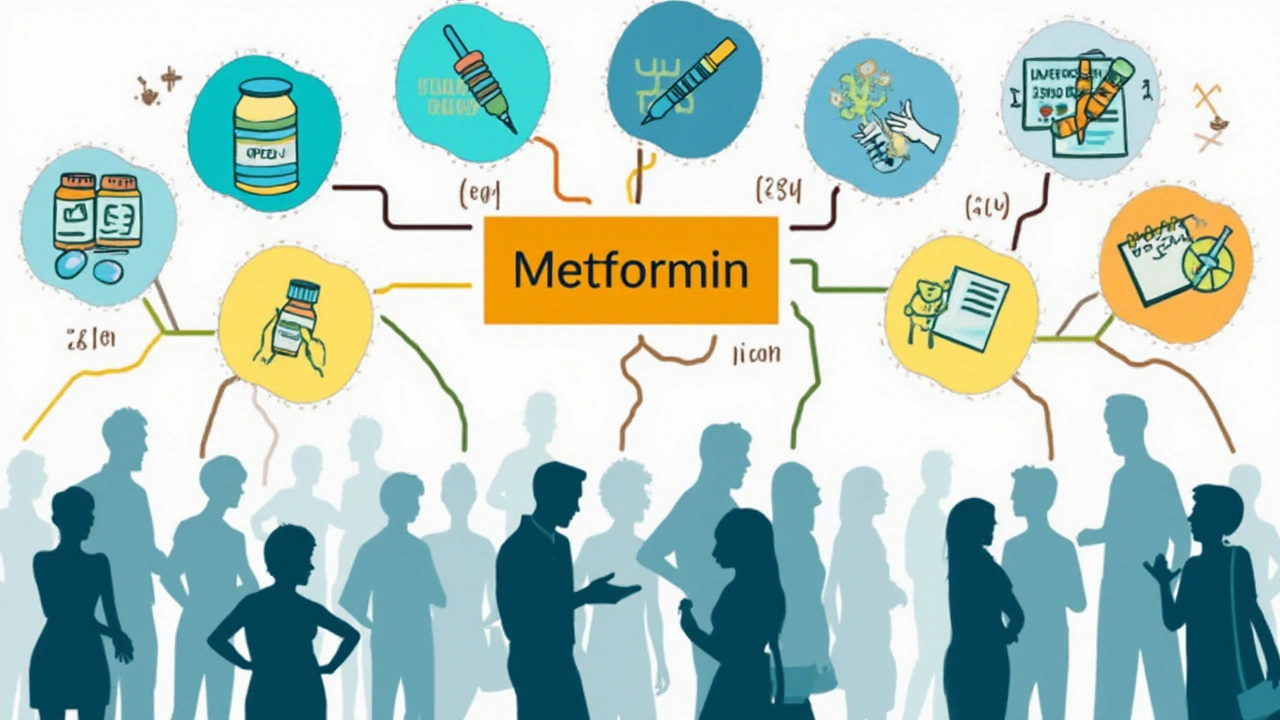Why People Look for Alternatives to Metformin
Metformin's been a staple for type 2 diabetes as far back as anyone can remember. It's reliable, usually well-tolerated, and pretty cheap—think old faithful. But not everyone gets on well with it. Some folks experience stomach troubles: nausea, diarrhea, cramps, or a few too many urgent bathroom runs. Others might see their vitamin B12 drop over the years, or have concerns about its impact on their kidneys, especially if they already have kidney issues.
The reality? No single diabetes med works for everyone. Our bodies—and our lives—don’t follow textbook rules. As the population ages, and more people juggle diabetes alongside heart or kidney conditions, the hunt for an effective, safer, or just-more-tolerable metformin alternative is picking up steam. A study led by Monash University in Melbourne found about 20% of Aussie adults prescribed metformin had to stop or switch within five years due to unwanted effects or poor blood sugar control. That’s not a fluke; it’s a trend. It’s also an opening: these days, you’ve actually got options.
But swapping your medication isn’t just about picking the next thing on a pharmacy shelf. Your age, budget, other medical needs, and even your appetite or sleep patterns play a role. Helping your doctor understand what matters most to you is the best way to dodge the pill roulette. And if you’re feeling stuck, there’s a silver lining: more research and new drugs than ever are changing the game for type 2 diabetes.
The Main Categories of Metformin Alternatives
If metformin isn't the right fit, the first thing your doctor will do is size up the alternatives based on how they work and how they fit your life. These meds fall into a few major buckets:
- Sulfonylureas: Names like gliclazide or glipizide. They prod your pancreas to release more insulin. The upside? They get your blood sugar down fast. The downside? Hypoglycemia (low blood sugar) and sometimes weight gain.
- GLP-1 Receptor Agonists: Brand names like Ozempic or Trulicity are in the spotlight. These are injectables—usually once a week. Beyond blood sugar, they help with weight loss, sometimes even lowering heart disease risk. But they can be pricey and can cause nausea, especially at the start.
- SGLT2 Inhibitors: These have names like empagliflozin or dapagliflozin. They work by making your kidneys shed extra sugar through pee. These can help heart and kidney health, and cause some weight loss. On the flip side, they can make urinary infections more likely and aren't ideal for people with advanced kidney problems.
- DPP-4 Inhibitors: These include sitagliptin, saxagliptin, and others. They're taken as tablets and are generally easy-going on the system with minimal side effects—but usually less dramatic blood sugar results.
- Thiazolidinediones: Like pioglitazone. They improve how your body uses insulin. They're not used as much these days due to concerns about weight gain, swelling, and even potential effects on the heart.
- Insulin: The old workhorse. Some people need to add it if tablets aren't cutting it, or if other health conditions make it necessary.
Why so many choices? Because diabetes isn’t a single-track problem. Two people with the same numbers can have totally different needs. That’s why doctors now think about medication side effects, costs, effects on weight, and even whether a drug will help your kidneys or heart when making the call. If you want the quick scoop on the best alternative to metformin, you’ll see all options neatly compared—worth a look if you want details lined up side-by-side.

Personal Factors: Age, Co-Existing Conditions, and Your Budget
Choosing a diabetes medication isn’t like shopping for shoes. It’s deeply personal, and everyone’s feet are a little different. Instead of just focusing on blood sugar, let’s talk about what really shapes your decision.
Age matters more than most people realize. The body deals with drugs differently as we get older—think less muscle, slower kidneys, altered appetite. A robust 40-year-old might handle a once-weekly injectable fine; a frail 80-year-old? Not so much. Older adults also face higher odds of medicine side effects—especially hypoglycemia. That means something gentle (like DPP-4 inhibitors) might fit better than a sulfonylurea in the elderly.
Co-morbidities sound daunting but just mean health problems that hang around with your diabetes. If you’ve got heart failure, doctors now often favor SGLT2 inhibitors—they seem to protect the heart and kidneys as well as control sugar. On the other hand, if your kidneys are already struggling, GLP-1 agonists could be a safer bet. Got issues with weight or sleep? GLP-1 drugs benefit weight and even seem to help sleep apnea. If you’re on a heap of medications, those with fewer interactions (like DPP-4 inhibitors) can make daily life less stressful.
And let’s not pretend budget isn’t part of the equation. In Melbourne (and everywhere else, honestly), newer meds can put a dent in your wallet unless you’re on public assistance like the PBS (Pharmaceutical Benefits Scheme). If cost is pressing, old-school sulfonylureas pack a punch for cheap, but carry risks. Generic versions of many drugs, including DPP-4 inhibitors, have started to appear, so ask your pharmacist what the true cost will be—sometimes, it’s a pleasant surprise.
Your family, job, travel schedule, and memory (yep, remembering doses!) all play a role in what will actually work in real life. I’ve met patients who could not stand daily pills but loved a once-weekly injection. Others hated needles so much that even fingerpricks were too much. None of this is just background information; it’s the meat and potatoes when choosing a metformin replacement.
Pros, Cons, and Real-World Tips for the Most Popular Alternatives
Beyond the basics, every diabetes med brings a mix of perks and pitfalls. Here’s a granular breakdown based on what people care about in daily life:
- Sulfonylureas:
- Cheap, easy to take as pills, and effective for most people in the short term.
- But frequent low blood sugars (especially if you skip meals or have kidney issues), weight gain, and potential to wear out over time.
- GLP-1 Agonists:
- Support weight loss, protect the heart, and lower A1C numbers fast.
- Downside? Nausea, injection site reactions, these aren’t pills, and prices are steep—but many say it’s life-changing if you can get access.
- SGLT2 Inhibitors:
- Tablets, usually once daily, help with blood sugar, weight, blood pressure, and protect the heart/kidneys.
- Watch for genital yeast infections and risk of dehydration. Not for those with significant kidney disease.
- DPP-4 Inhibitors:
- Super easy to tolerate—little risk of hypos or weight gain. Pills once a day, play nicely with other meds.
- Less powerful effect on blood sugar and no real benefit for weight or heart protection.
- Pioglitazone:
- Pill, low risk of hypos, and helps if insulin resistance is an issue.
- Watch for weight gain, swelling, and bone thinning. Not usually first choice anymore, but still has a unique place.
- Insulin:
- Works for everyone when blood sugars are wild or after many years with diabetes.
- Requires injections, regular monitoring, careful food balancing; can be intimidating but sometimes necessary.
Bad at remembering meds on a schedule? Apps or simple pill organizers help people stay consistent and get the full benefit from whichever new option you end up picking. If you’re planning travel, talk with your GP about storage—SGLT2 inhibitors and DPP-4s take up almost no space, but injectable GLP-1s may need fridge time and careful packing.
If you’re struggling with the decision, ask for a medication trial—many doctors are open to brief periods on a new drug with follow-ups. And get labs checked before and after. Even a couple of weeks might confirm if you’ve found something that agrees with you (or doesn’t).

How to Talk With Your Doctor About Switching from Metformin
Conversations about changing diabetes meds can feel intimidating. Remember, your doctor can’t read your mind—they want specifics about what you’ve tolerated, what annoys you, what’s realistic with your life, and what you hope to achieve beyond just the numbers.
Start by laying out how your body responds to metformin. How are your sugar readings? Has your weight changed? Are you struggling with bathroom issues, vitamin levels, or other side effects? Write down anything unusual, even if you think it’s unrelated.
Think about what you want in your next medication. Is it fewer pills, fewer side effects, better insurance or government coverage, or something that won’t impact a hobby or your job? The clearer you are, the easier it is for your doctor to narrow the choices. Mention your other health issues and meds so they can be factored in quickly—this speeds up the safe matching process.
If the price is a dealbreaker, say that upfront. Your provider may have samples, or you might qualify for a government subsidy. Drug reps sometimes provide starter packs for certain injectables or newer tablets—ask about these, as they’re rarely offered unless you nudge the right person.
And don’t rush. Changing diabetes medication is a commitment. If you feel out of depth, bring a partner, friend, or family member for support or as an extra set of ears to help remember the nitty-gritty details after you leave the office.


11 Responses
I switched from metformin to empagliflozin last year and my stomach finally stopped rebelling. Also lost 18 lbs without trying. No more 3am bathroom marathons. Game changer.
But yeah, my yeast infection count went up. Just saying.
It is, of course, imperative to acknowledge that the pharmacokinetic profile of GLP-1 receptor agonists fundamentally alters the metabolic landscape in a manner that supersedes the antiquated mechanisms of sulfonylureas. One must not conflate efficacy with convenience, nor should one permit cost-benefit analyses to eclipse evidence-based outcomes. The data are unequivocal.
Ozempic is basically the new yoga. Everyone’s on it, nobody admits they’re just doing it to lose weight, and half the people are throwing up in the bathroom after brunch. I get it. But come on. If your doctor’s pushing it because they’re tired of your ‘I can’t eat carbs’ drama, maybe try therapy first?
I’m so tired of people acting like metformin is the devil. It’s been around for 60 years. You’re not special. Your gut is not that sensitive. You just don’t want to take a pill that costs $4 and doesn’t come with a TikTok influencer endorsement. Grow up.
Honestly, I think we’re all just trying to find the thing that lets us live without feeling like a science experiment. Metformin wrecked my digestion, but I didn’t want to start shots. Took me 8 months to try a DPP-4. Now I take one pill, don’t crash after lunch, and my wife says I’m less grumpy. Not magic. Just better.
Also, pill organizer saved my life. Seriously. Buy one.
The author’s conflation of anecdotal experience with clinical utility is a textbook example of evidence erosion. The Monash study cited has a significant attrition bias, and the suggestion that patient preference supersedes HbA1c trajectory is dangerously reductionist. One cannot substitute lifestyle metrics for biomarker outcomes.
Thank you for this thoughtful, nuanced overview. I’ve been on pioglitazone for five years and was afraid to speak up because everyone else seems to hate it. But it’s kept my insulin resistance stable without hypoglycemia. I wish more people knew it still has a place - especially for those with PCOS or fatty liver. Not perfect, but it’s mine.
In Canada, we’ve got the PBS equivalent - the pan-Canadian Pharmaceutical Alliance. Generic sitagliptin is like $12 a month now. If you’re in the US and paying $300, you’re being played. Ask your pharmacist for the cash price - it’s often cheaper than insurance. Also, if you’re on a budget, sulfonylureas still work. Just don’t skip meals.
You people are overthinking this. If metformin makes you poop your pants, take it with food. If you can’t handle that, just get on Ozempic. It’s not rocket science. Stop reading blogs and go see your doc. They’re not trying to scam you - they’re trying to keep you alive.
Metformin is a relic. Like dial-up. The real revolution is in the SGLT2 inhibitors - they don’t just lower glucose, they rewire your body’s relationship with survival. You’re not treating diabetes anymore. You’re upgrading your biological OS. And if you’re still clinging to pills because you’re scared of needles? That’s not caution. That’s fear dressed as wisdom.
I had a patient last week who said, 'I just want to be able to eat dinner without feeling like I’m going to pass out.' We switched her from metformin to a DPP-4. She cried. Not from the meds - from relief. Sometimes the goal isn’t perfect numbers. It’s peace. Thank you for writing this without hype.